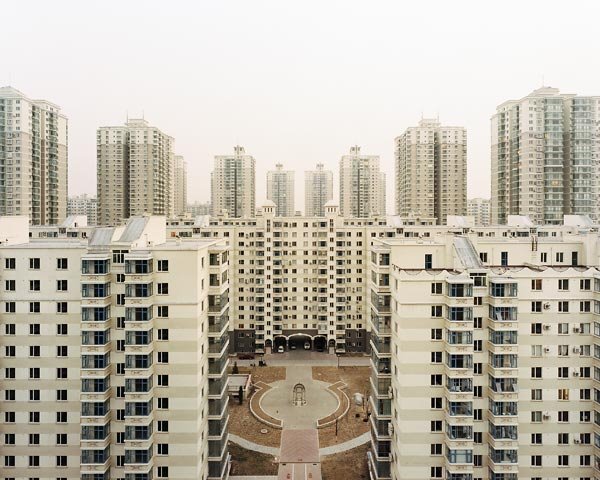A stadium modeled after a birds’ nest, a z-shaped skyscraper, the largest airport in the world and an opera house that looks like an egg. Approved in the wake of
Beijing’s Olympics win and
China’s entry into the WTO and still unfinished, buildings like these, each by a renowned foreign architect, are already helping shape
Beijing of the future.
But they could soon become things of the past. An “opinion” released last month by the Ministry of Construction and four other government bodies seeks greater restrictions on large-scale public building projects—an edict apparently aimed at outlandish and costly designs by foreign architects.
 above, the proposed ren building in Shanghai, by Dutch firm PLOT
above, the proposed ren building in Shanghai, by Dutch firm PLOT
“In recent years, in some places there's been a fever for international tenders for major public buildings, especially landmark projects,” said an unnamed spokesman, according to the Chinese government's official Web site, gov.cn. “Some foreign architects are divorced from China's national conditions and single-mindedly pursue novelty, oddity and uniqueness.”
While the beginning of the decade saw rampant rubber-stamping of ambitious construction and development projects, the central government has lately sought to cut down on wasteful projects in an attempt to rein in economic growth and reduce energy use.
“Some local governments aren't acting in the interest of national conditions and financial strength, crave unrealistic 'achievement projects' or 'image projects', don't emphasize conservation of energy and resources, or use too much land,” said the document, avoiding specifics.
Among those welcoming the new provisions was Peng Peigen, a professor of architecture at Tsinghua University who has been China’s most outspoken critic of “bad and ugly” foreign architecture. The document, which he hailed as a “major decision,” could reach provincial and municipal levels within two years. “But,” he said, “it will take eight to ten years to heal the wounds to the city’s morphology.”
For years, Peng and a group of Chinese architects have captivated the press and national leaders with their publicity campaigns against some of Beijing’s biggest foreign projects. For instance, he says Herzog and de Meuron’s National Stadium is oppressive in form, wasteful for its use of steel, and at odds with Beijing’s layout. (The design beat Peng’s own Olympic submission, which positioned a flowering stadium directly along the city’s central axis.)
But Peng’s public enemy no. 1 is Paul Andreu’s Grand National Theater—dubbed the “ducks’ egg” by some—which he says is extravagant and grossly out of touch with its surroundings. Last year, he wrote to Premier Wen Jiabao criticizing it and other of China’s “monsters” by foreign architects who see China as a “new weapons testing ground.”
Still, Peng, who is a Canadian citizen, is quick to point out that some of his favorite buildings are foreign-made, including Adrian Smith’s iconic Jin Mao Tower in Shanghai, and even Herzog and de Meuron’s tubular Munich Allianz Arena, which he says is much lighter and more efficient than their Beijing stadium. “[We’re against] architecture that’s bad,” he said. “It’s not because it’s foreign.”
But the new document places a premium on domestic submissions for construction and design plans over the work of foreigners. Until very recently, foreign architecture companies were required to cooperate with local design firms on any project. While the requirement was meant to encourage exchange and provide checks, most foreign architects have lamented the cultural and technical hurdles of working with China’s quickly developing architectural sector.
But despite the challenges, local partnerships are key, said John Pauline of Australian architects PTW. His team worked with a local design firm to develop the National Aquatics Center, nicknamed the “Watercube,” said to be the public’s favorite Olympic design. “It’s almost impossible to do architectural work here without collaboration,” he said. “And if we hadn’t collaborated, the Watercube wouldn’t look anything like the way it does.”
Hoping it isn’t the start of a wider, stricter campaign against foreign designs, Pauline sees the government’s warning as part of a growing process. He recalls how Sydney’s famous Opera House was met with public uproar in the 1950s, especially for its Danish pedigree. “‘Why are you taking work from Australian architects?’ people wondered then. Now you wouldn’t find one person who would say that,” he said. “It’s just something you have to embrace.”
“Foreign architects, whether they be European, Korean, Japanese, improve Beijing, they don’t set it back in terms of aesthetics,” he said. “The more you’ve got the better off you are.”
A version of this ran in That's Beijing HOME in April 2007
 If there’s a modern soundtrack to the kind of wanton behavior witnessed at sweaty, shirtless, college dance parties, Myth Takes deserves a place on it. Previous records from the aptly-named dance-punk outfit (pronounced with three clucks of the tongue) had bursts of brilliance but couldn’t match the live performances, wherein seven men armed with searing guitars, horns and a trance-inducing rhythm section back up the indefatigable, party-starting Nic Offer. But that consistent live energy is sprinkled all over this new record, from the twangy, tribal title track to the album’s spacey, funky centerpiece, the courtship treatise Heart of Hearts. If it occasionally gets to be a bit repetitive, well, then you’re listening too hard … and not dancing hard enough!!! Alex Pasternack
If there’s a modern soundtrack to the kind of wanton behavior witnessed at sweaty, shirtless, college dance parties, Myth Takes deserves a place on it. Previous records from the aptly-named dance-punk outfit (pronounced with three clucks of the tongue) had bursts of brilliance but couldn’t match the live performances, wherein seven men armed with searing guitars, horns and a trance-inducing rhythm section back up the indefatigable, party-starting Nic Offer. But that consistent live energy is sprinkled all over this new record, from the twangy, tribal title track to the album’s spacey, funky centerpiece, the courtship treatise Heart of Hearts. If it occasionally gets to be a bit repetitive, well, then you’re listening too hard … and not dancing hard enough!!! Alex Pasternack 
